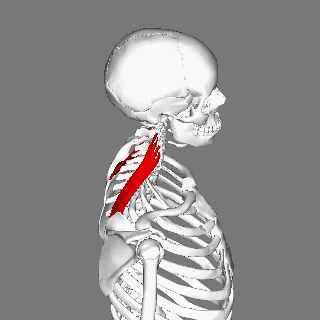Description
Levator scapulae is a posterior Axio-appenducular muscle that connects the upper limb to the vertebral column and lies in the posterior triangle of the neck. The superior aspect of the levator scapulae is covered by sternocleidomastoid, and its inferior part by trapezius.[1]
Origin
The levator scapulae originates on the posterior tubercle of transverse process of cervical vertebrae 1 to 4.[2]
Insertion
The levator scapulae inserts on to the vertebral margin of the scapula between the superior angle and the root of the spine.[3]
Position
The superior third of the strap-like levator scapulae lies deep to the sternocleidomastoid while the inferior third is deep to the trapezius. From the transverse processes of the upper cervical vertebrae, the fibers of the levator of the scapula pass inferiorly to the superomedial border of the scapula.[1]
Nerve Supply
The levator scapulae is innervated by cervical nerve (C3-C4) and dorsal scapular nerve (C5).[4]
Blood Supply
Descending scapular artery[5]
Function
The levator scapulae elevates and rotates the scapula.[2] The levator scapulae elevates and rotates the inferior angle medially, when the spine is fixed. When the unilateral shoulder is fixed the levator scapulae rotates the scapulae to the same side and flexes the spine laterally. When bilateral shoulders are fixed the levator scapulae co-contract equally causing a gross flexion/extension of the cervical spine.Acting bilaterally (also with the trapezius), the levators extend the neck; acting unilaterally, the muscle may contribute to lateral flexion of the neck (toward the side of the active muscle).[1]
Clinical Relevance
Forward head posture puts increased tension on the levator scapulae muscles to co-contract for cervical extension in an elongated position.[6] Increased tightness in the levator scapulae due to increased activity from a forward head posture can lead to cervicogenic headaches.
Assessment
The levator scapulae length and tension can be assessed by placing the patient in supine, stabilizing the ipsilateral scapula, and contralateraly side bend and rotate the head. Also, trigger points are common in this muscle and can be palpated for in both the superior attachment and inferior attachment.
Treatment
Pain or discomfort caused by the levator scapulae can be relieved by various modalities and active movements to provide relief.
References
- ↑ 1.01.11.2 Keith, L., Arthur, F. and Anne, M. (n.d.). Moore Clinically Oriented Anatomy. 7th ed.
- ↑ 2.02.1 ↑ Marieb EN, Hoehn K. Human anatomy & physiology. 10th ed. Boston, Ma: Pearson; 2016.
- ↑ Gray, Henry. Anatomy of the Human Body. Philadelphia: Lea & Febiger, 1918; Bartleby.com, 2000. www.bartleby.com/107/121.html
- ↑ Joseph P Iannotti, Richard Parker.fckLRThe Netter Collection of Medical Illustrations: Musculoskeletal System, Volume 6, Part I – Upper Limb. Elsevier Health Sciences. 2012
- ↑ Kim E-K, Kim JS. Correlation between rounded shoulder posture, neck disability indices, and degree of forward head posture. J Phys Ther Sci [Internet]. 2016 Oct [cited 2018 Jul 4];28(10):2929–32. Available from: https://www.ncbi.nlm.nih.gov/pmc/articles/PMC5088155/



